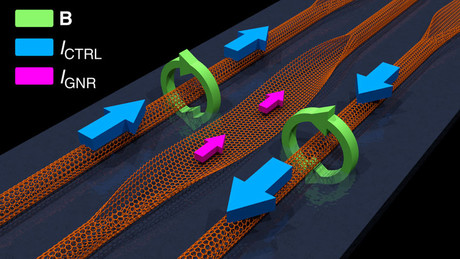A new spin on transistors

A US engineer has designed a novel computing system, made entirely from carbon, which may one day replace the silicon transistors that power today’s electronic devices. The resulting all-carbon spin logic proposal is a computing system that could be made smaller than silicon transistors, with increased performance.
Today’s electronic devices are powered by transistors, which are tiny silicon structures that rely on negatively charged electrons moving through the silicon, forming an electric current. Transistors behave like switches, turning current on and off. In addition to carrying a charge, electrons have another property called spin, which relates to their magnetic properties.
In recent years, engineers have been investigating ways to exploit the spin characteristics of electrons to create a new class of transistors and devices called ‘spintronics’. Joseph S Friedman joined in on this trend back when he was a doctoral student at Northwestern University, creating an all-carbon, spintronic switch that functions as a logic gate that relies on a basic tenet of electromagnetics.
As an electric current moves through a wire, it creates a magnetic field that wraps around the wire. In addition, a magnetic field near a two-dimensional ribbon of carbon — called a graphene nanoribbon — affects the current flowing through the ribbon. In traditional, silicon-based computers, transistors cannot exploit this phenomenon. Instead, they are connected to one another by wires. The output from one transistor is connected by a wire to the input for the next transistor, and so on in a cascading fashion.
In Friedman’s spintronic circuit design, electrons moving through carbon nanotubes — essentially tiny wires composed of carbon — create a magnetic field that affects the flow of current in a nearby graphene nanoribbon, providing cascaded logic gates that are not physically connected. As noted by Friedman, “The concept brings together an assortment of existing nanoscale technologies and combines them in a new way.”
Because the communication between each of the graphene nanoribbons takes place via an electromagnetic wave, instead of the physical movement of electrons, Friedman expects that communication will be much faster, with the potential for terahertz clock speeds. In addition, these carbon materials can be made smaller than silicon-based transistors, which are nearing their size limit due to silicon’s limited material properties.
Friedman said work towards a prototype of the all-carbon, cascaded spintronic computing system will continue in the interdisciplinary NanoSpinCompute research laboratory, which he now directs at UT Dallas. His research has been published by in the journal Nature Communications.
Computer hardware advance solves optimisation challenges
A new hardware advance could redefine how industries solve large-scale optimisation challenges,...
‘Microwave brain’ chip for ultrafast, wireless computing
Researchers have developed a low-power microchip called ‘microwave brain’ — a...
Monash University unveils AI research supercomputer
Monash University has revealed the development of an advanced AI supercomputer, as part of a...





